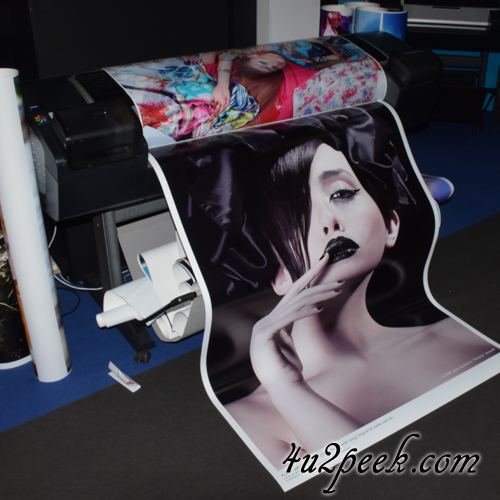Getting Big Printouts
 And there she slid on the floor, Japan's world famous fashion model, inch by inch she appeared sharp and crisp. A few moments later, she was clearly visible a flawless face that was surely, larger than life size. The big printer became silent and her picture lay on the floor, a little wider than three feet. A picture speaks a thousand words and the larger the picture, the clearer and louder the message. Whether you happen to be running a small home business or head the publicity department of a multinational empire, there are likely to be times when a big printing job needs to be done. Depending on the frequency of such requirements and budgets available, you could decide to use a professional printing service or procure a large printer for yourself. No matter which option you choose, it is a good idea to have a basic ideas of the main issues involved in printing large printouts. Getting something done that is too fancy and beyond your requirements might be a waste of money. On the other hand, ending up with something that does not fit your purpose can be a waste of time and money. Be clear on your requirements, the following information should keep you focused on the right track.
And there she slid on the floor, Japan's world famous fashion model, inch by inch she appeared sharp and crisp. A few moments later, she was clearly visible a flawless face that was surely, larger than life size. The big printer became silent and her picture lay on the floor, a little wider than three feet. A picture speaks a thousand words and the larger the picture, the clearer and louder the message. Whether you happen to be running a small home business or head the publicity department of a multinational empire, there are likely to be times when a big printing job needs to be done. Depending on the frequency of such requirements and budgets available, you could decide to use a professional printing service or procure a large printer for yourself. No matter which option you choose, it is a good idea to have a basic ideas of the main issues involved in printing large printouts. Getting something done that is too fancy and beyond your requirements might be a waste of money. On the other hand, ending up with something that does not fit your purpose can be a waste of time and money. Be clear on your requirements, the following information should keep you focused on the right track.
- Most printers that can handle printing widths of 3 feet and above are based on some type of ink, most commonly referred to as inkjet printers. Laser printers would be too expensive and are generally not made to handle such large widths.
- Printouts from big printers that are done on paper, can make use of glossy or matt (dull) finished paper. A glossy paper will reflect a lot of light and the printout might not be easily readable from all angles. Matt finished paper has a dull surface and is suitable to many light conditions.
- Large printers that can print wide printouts on PVC or similar material are also available. Such printouts can generally withstand moisture or water. They are surely more suitable than paper printouts if, they are to be put outdoors.
- Printouts on paper are obviously more likely to get cut or torn as compared to printouts done on PVC or other durable materials. Make a decision based on the location where the printout will be displayed and also, whether it is going to be stored for future use.
- Certain types of ink used in a big printer are more likely to fade as compared to others. Talk to the printing service about this. While all printouts are likely to fade when exposed to light for a significant duration, some printouts can fade faster than others.
- Printing services often provide laminating options, a big paper printout can be laminated on to a hardboard and be coated with a fine transparent film. Request information on different types of lamination and evaluate them based on costs involved.
- If you decide to buy a big printer, keep in mind that leaving the machine unused for a long time can cause the print heads and ink to dry up. Cleaning might be required before they can be effectively used again, the cleaning process might not be very easy or convenient.
- When buying a large printer, get a clear understanding of the terms of the warranty. Besides the duration of the warranty, you should also be aware of conditions or usage that, can nullify the warranty. Consider a situation where your large printer has to be sent to the service center for a few days, how will this affect your printing requirements. Can the dealer provide you with a spare printer or at least, allow you to get your printing jobs done in his office.
We would recommend that you read the 4u2peek Big Printer Report, to get a better understanding on this topic. This report should be of special interest to anyone thinking of buying a large printer. While professional printing houses are well versed with various printers, other business organizations need to consider many factors before deciding on a specific printing machine.
